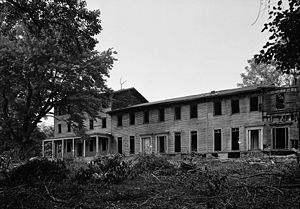- North American Phalanx
-
The North American Phalanx (NAP) was a secular Utopian community located in Colts Neck Township, in Monmouth County, New Jersey. The NAP was based on the ideas of Charles Fourier, and lasted from 1843 to 1855-1856.[1]
Contents
Fourier and founding the community
Fourier was a French philosopher who believed people would be better off living in communal societies rather than individual, private living. Fourier developed the idea of the phalanstère, a community of 1,620 based in a single structure. In the phalanstère, there would be private property, but many activities including eating and cooking would be communal. Fourier had many American followers, including Albert Brisbane who did a great deal to popularize Fourierism in the United States.
Charles Sears, a follower of Brisbane, decided to make Fourier's ideas a reality. He and Nathan Starks founded a Fourierist group in Albany, New York. Sears would take on several leadership roles in the course of the NAP's history. Several people including Brisbane, Horace Greeley, and Park Goodwin helped create a commission to found the community. For $14,000, the commission purchased 673 acres (2.72 km2) in Monmouth from Hendrick Longstreet and Daniel Holmes on January 1, 1844. Settlement began over 6 months with men starting the community and women and children joining in the Spring of 1845.
Site
The original site consisted of two farmhouses. In 1847, a three-story addition was built between the two houses to form a single structure. The farmhouses were converted into a kitchen and eating area while the addition was used for living quarters and social areas.
The community also included "a stream mill, stables, cow and wagon sheds, forges, carpenter shops, a packing house, a school, a day nursery for working mothers, guest cottages, landscaped gardens and paths, and an artificial pond for bathing, boating and ice harvesting in the winter."[1]
Associates
Members of the community were referred to as associates. For most of the NAP's history it had a population of 120-150. Living standards in the NAP were better than average for the country and area at that time. Members were mostly from the Northeast and lower or middle class. People were offered admission based on their skills. Prospective members lived in the community for 30 days before being offered one-year provisional memberships, after which they became full members upon approval of the community. The entire community voted on membership status throughout the process.
Administration
The NAP had a constitution, written in 1843, which provided for administration through a council. Originally, only stockholders voted in elections for the council, but all members were given a vote in an 1848 amendment. The council was composed of a president, vice-president, a treasurer, and twelve directors. Directors served for two years, with staggered terms so that half were elected each year. The rest of the council served one-year terms.
Economy
The NAP had a steady, but slowly declining economy. The NAP divided into six groups: agriculture, livestock, manufacturing, domestic matters, social plans, and education. Wages were below minimum wage compared to American standards, but so was the cost of living, being around $2 per week.
Dissolution
The community faced a split in 1853 over the women's rights and abolitionist movements and a controversial plan to add a religious affiliation to the community. Many members left over this dispute.
A fire swept through on September 10, 1854. The fire destroyed mills and several workshops. The community’s insurance company went bankrupt, and the NAP could not deal with the $10,000 in damages. The community voted to sell its estate in June 1855. Operations ceased in early 1856 and the NAP was legally dissolved on January 1, 1857.
The Phalanx building stood until November 1972 when it was destroyed in another fire.
At present, two structures from the original Phalanx property survive. Both are private homes. One of them, constructed circa 1851, was the cottage of Marcus Spring, a Brooklyn, New York merchant and supporter of the Phalanx. Mr. Spring and his family used the cottage as their Summer home. Although Mr. Spring was not a resident member of the Phalanx, he was one of its largest shareholders. Mr. Spring and his New York colleagues invested over $50,000 in the Phalanx.
See also
Archive
The Monmouth County Historical Association at 70 Court Street in Freehold Borough, New Jersey houses a collection of corporate records which include legal and financial documents, miscellaneous manuscripts, genealogical material, bills of fare, printed material, photographs and illustrations, maps, drawings, and blueprints. It is a subject collection acquired through various donors. The bulk of material dates from 1853 to 1879.
References
- ^ Densky, Lois R (May 1980). "Collection 5:North American Palanx:Records 1841-1972". http://www.monmouthhistory.org/Sections-read-20.html. Retrieved July 9, 2011.
- "North American Phalanx Collection, 1841 - 1972." The Monmouth County Historical Association. May 1980. [2] (Source for all information for the original article).
External links
Categories:- Utopian communities
- History of New Jersey
- Monmouth County, New Jersey
- Populated places established in 1841
Wikimedia Foundation. 2010.


